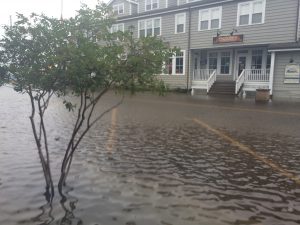NOAA’s National Centers for Coastal Ocean Science (NCCOS) is awarding over $1.5M in FY19 for research into the ability of natural coastal habitats and partially engineered or restored habitats to reduce the impacts of sea level rise and flooding and improve the resilience of their communities.

Coastal communities and the surrounding ecosystems are threatened by rising seas and coastal flooding that alters shorelines making people, homes and businesses more vulnerable to coastal storms. Rising sea levels can also change how ecosystems work, especially when combined with inundation from tides and storms. With increasing threats to our coasts, enhancing resilience to sea level rise and flooding has become a national priority.
Funding under NOAA’s Ecological Effects of Sea Level Rise Program will support six new and three continuing projects in California, Florida, Chesapeake Bay, North Carolina and the Pacific Northwest.
New Awards:
- George Mason University, Maryland Department of Natural Resources and The Nature Conservancy received $247,050 to enhance models that quantify the benefits of natural and nature-based features in Chesapeake Bay to inform management and conservation under future sea level rise scenarios.
- University of Wyoming, Point Blue Conservation Science, University of Texas Arlington and U.S. Geological Survey received $249,862 to develop a model that will compare the effectiveness of natural and nature-based features in providing shoreline protection in California.
- College of William & Mary/Virginia Institute of Marine Science, U.S. Army Corps of Engineers and Virginia Commonwealth University received $249,675 to assess the ecological history of dunes in coastal protection from storms and sea level rise.
- University of Florida, Florida Gulf Coast University, South Florida Water Management District, U.S. Geological Survey, University of Miami, U.S. Army Corps of Engineers, and Rada Engineering, Inc. received $250,000 to develop a coupled coastal and inland flooding model and a dynamic mangrove vegetation model to assess the role of mangroves in enhancing coastal resilience.
- Oregon State University received $249,033 to document the environmental and economic benefits provided by tidal wetlands in the Pacific Northwest, and predict the impact of sea level rise on those benefits.
- Oregon State University received $249,802 to optimize the ecosystem services of U.S. Pacific Northwest coastal beaches and dunes.
Continuing Awards:
- University of California Irvine received $287,500 to develop modeling tools to study the effect of sediment management practices on the resilience and vulnerability of coastal communities and ecosystems in southern California
- California State Coastal Conservancy received $179,975 to investigate the effects of sea level rise on estuarine systems of southern California
- Louisiana State University received $300,000 to enhance models that evaluate the ecological and economic value of nature based features to mitigate surge and nuisance flooding
Expected outcomes from these projects include guidance on the value and effectiveness of natural features on providing flood and habitat protection, increased accuracy in predictions of SLR enhanced storm surge, wave run-up, and nuisance flooding vulnerability, and enhanced coastal resource sustainability through improved management plans and conservation.
The overall goal of EESLR is to facilitate informed adaptation planning and coastal management decisions through a multidisciplinary research program. Resulting products could be integrated models and tools of dynamic physical and biological processes capable of evaluating vulnerability and resilience under multiple sea level rise, inundation, and management scenarios. These awards contribute to a larger NOAA effort to provide science to inform decisions, conserve priority ecosystems, and advance the use of natural based infrastructure to mitigate the effects of coastal hazards.
A full list of the grant awards is available here.
NOAA Press Release available here.
